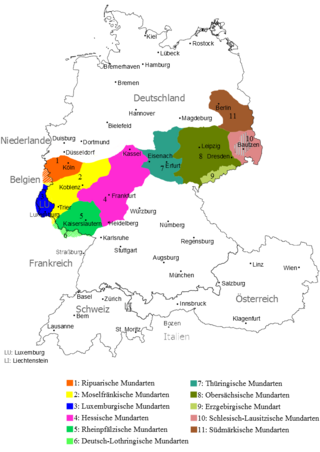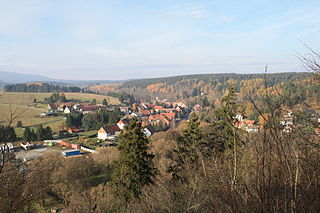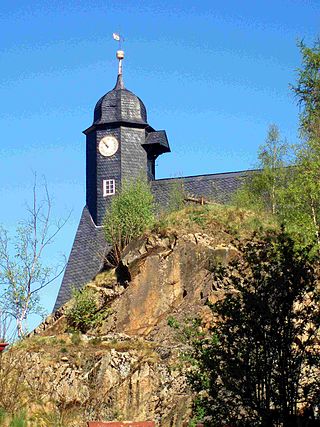
Clausthal-Zellerfeld is a town in Lower Saxony, Germany. It is located in the southwestern part of the Harz mountains. Its population is approximately 15,000. The town hosts the Clausthal University of Technology. The health resort is located in the Upper Harz at an altitude between 390 and 821 m above sea level.

"Nikolaus" Storzenbecher or "Klaus" Störtebeker was reputed to be leader of a group of privateers known as the Victual Brothers. The Victual Brothers were originally hired during a war between Denmark and Sweden to fight the Danish and supply the besieged Swedish capital Stockholm with provisions. After the end of the war, the Victual Brothers continued to capture merchant vessels for their own account and named themselves "Likedeelers". Recent studies manifest that Störtebeker was not called "Klaus" but "Johann".
Oberharz is a former Samtgemeinde in the district of Goslar, in Lower Saxony, Germany. It was situated in the western part of the Harz, approx. 15 km southwest of Goslar. Its seat was in the town Clausthal-Zellerfeld. It was disbanded in January 2015, when its member municipalities merged into the town Clausthal-Zellerfeld.
Wildemann is a town and a former municipality in the district of Goslar, in Lower Saxony, Germany. It has been part of the town Clausthal-Zellerfeld since January 1, 2015. It is situated in the west of the Harz, northwest of Clausthal-Zellerfeld. It was part of the former Samtgemeinde Oberharz.

Altenau ( ) is a town and a former municipality in the district of Goslar, in Lower Saxony, Germany. Since 1 January 2015 it is part of the town Clausthal-Zellerfeld.

Elbingerode is an Ortsteil of Oberharz am Brocken in the Harz district, in the German state of Saxony-Anhalt. The former town was incorporated into the newly established municipality on 1 January 2010. Its population is 3,101 (2021).

Benneckenstein is a town in the district of Harz, in Saxony-Anhalt, Germany. Since 1 January 2010, it has been part of the town of Oberharz am Brocken. Benneckenstein is in the eastern Harz, 14 km southeast of Braunlage, and 24 km south of Wernigerode. Its population is 1,698 (2021).

Hasselfelde is a town in the district of Harz, in Saxony-Anhalt, Germany. It is in the eastern Harz, approximately 17 km south of Wernigerode. Since 1 January 2010 it has been part of the town of Oberharz am Brocken. Its population is 1,941 (2021).

Brocken-Hochharz was a Verwaltungsgemeinschaft in the district of Harz, in Saxony-Anhalt, Germany. It was situated in the Harz mountains, southwest of Wernigerode. It was named after the highest peak of the Harz: Brocken. The seat of the Verwaltungsgemeinschaft was in Hasselfelde. It was disbanded on 1 January 2010, when most member municipalities merged into the newly formed town of Oberharz am Brocken, with the exception of Allrode.

Schulenberg im Oberharz is a village and a former municipality in the district of Goslar in Lower Saxony, Germany. It has been part of the town Clausthal-Zellerfeld since January 1, 2015.

Erzgebirgisch is a (East) Central German dialect, spoken mainly in the central Ore Mountains in Saxony. It has received relatively little academic attention. Due to the high mobility of the population and the resulting contact with Upper Saxon, the high emigration rate and its low mutual intelligibility with other dialects, the number of speakers is decreasing.
Elend is a district of the town of Oberharz am Brocken in the Harz District, in Saxony-Anhalt, Germany. It lies in the Bode valley in the High Harz in central Germany, at a height of 505 m above NN. This part of the valley is known locally as Elendstal. Elend is located near the former Inner German Border between West and East Germany. Its population is 318 (2021).
Stiege is a village and a former municipality in the district of Harz, in Saxony-Anhalt, Germany. Since 1 January 2010, it is part of the town Oberharz am Brocken. Its population is 862 (2021).

Tanne is a village and a former municipality in the district of Harz, in Saxony-Anhalt, Germany. Since 1 January 2010, it is part of the town Oberharz am Brocken. Its population is 473 (2021).

The Upper Harz is the northwestern and higher part of the Harz mountain range in Germany. The exact boundaries of this geographical region may be defined differently depending on the context. In its traditional sense, the term Upper Harz covers the area of the seven historical mining towns (Bergstädte) - Clausthal, Zellerfeld, Andreasberg, Altenau, Lautenthal, Wildemann and Grund - in the present-day German federal state of Lower Saxony. Orographically, it comprises the Harz catchment areas of the Söse, Innerste and Grane, Oker and Abzucht mountain streams, all part of the larger Weser watershed.

Rübeland is a village in the district of Harz in the German state of Saxony-Anhalt. Since 2004, it has been given the additional description of Höhlenort. The sub-districts of Rübeland are Susenburg, Kaltes Tal, Kreuztal and Neuwerk. Since 1 January 2010, it is part of the town Oberharz am Brocken. Its population is 424 (2021).

Königshütte is a German village in the district of Harz, in the state of Saxony-Anhalt. Since 1 January 2010 is a part of the municipality of Oberharz am Brocken. Its population is 452 (2021).

Oberharz am Brocken is a town in the Harz District, in Saxony-Anhalt, Germany. It was formed on 1 January 2010 by the merger of the town of Elbingerode with the municipalities of the former Verwaltungsgemeinschaft Brocken-Hochharz.

Trautenstein is a village in the borough of Oberharz am Brocken in the district of Harz in the German state of Saxony-Anhalt. Formerly an independent municipality, it was merged into the town Hasselfelde in 2002, which was merged into Oberharz am Brocken in 2010. Its population is 390 (2021).


















